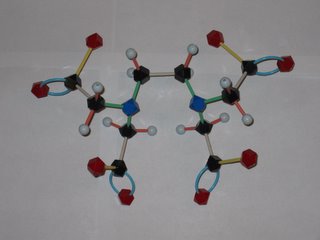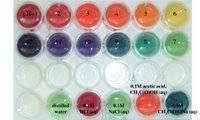Tuesday, January 31, 2006
Many transition metals react with bases (such as ammonia) to produce beautifully colored transition metal-ligand complexes. The word ligand comes from the Latin ligare which means to tie or bind. The same root leads to ligaments, which tie your bones together.
Weird Words of Science: Tooth and Claw - Chelation

There has been a lot news coverage lately about the abuse of chelation therapy for treating autism and other disorders. So what's a chelate and how does it work to remove metal ions from the body? EDTA is shorthand for ethylenediamminetetraacetic acid, which has the structure shown at the left. The disodium calcium salt of EDTA is the usual chemotheraputic form. Lone pairs of electrons on the nitrogens and oxygens of the EDTA (tagged blue and red in the photo) latch onto the metal. This Lewis acid-base reaction results in the metal being sequestered inside the EDTA molecule. Tucked away inside the EDTA, the metal can't accumulate in the body's tissues and is eventually eliminated. EDTA has different affinities for different metal ions, but is a pretty effective scavenger of most metal ions, including iron and calcium. Later this semester we will learn more about how to tell which metals will be removed more efficiently. Removal of too much calcium can result in cardiac arrest, so EDTA is not without safety isses!
The word chelation come from the Greek for claw. Molecules that attach to metals at multiple points, like EDTA, are called multidentate ligands from their capacity to "bite" onto the metal. EDTA makes a hexadentate metal-ligand complex (6 points of attachment) with some ions, a pentadentate complex with others.
The photo is courtesy of a Chem 104 student!
Monday, January 30, 2006
How to look like a chemist: Drawing chemical structures

Chemists often don't show all the hydrogen atoms in a molecule, since they can clutter up the picture (and often aren't involved in the reaction). Often they use representations that omit the carbons, assuming that carbons are at the end of any line segment (see the structure on the far left). If they want to indicate hydrogens, often they will embed the H's with the carbons, as in the middle structure. The structure at the far right is unlikely to be drawn by a practicing chemist - who would use either of the two models on the left!
How to talk like a chemist: Hydroxide, hydroxyl? Aren't they the same thing?
 The glucose molecule shown at left has lots of OH's on it. Are these hydroxides? Technically, no. Hydroxides are ions, individual OH- units, either in solution or in a crystal. In glucose, the OHs are termed hydroxyl groups, where the OH is bound covalently to the molecule. The name gives a clue to the chemical structure and expected reactivity!
The glucose molecule shown at left has lots of OH's on it. Are these hydroxides? Technically, no. Hydroxides are ions, individual OH- units, either in solution or in a crystal. In glucose, the OHs are termed hydroxyl groups, where the OH is bound covalently to the molecule. The name gives a clue to the chemical structure and expected reactivity!Alchohols have as a distinguishing feature a hydroxyl group, and therefore don't behave as bases (losing hydroxide ions) like sodium hydroxide would, even though their chemical formulas might look similar. For example, compare the formulas for sodium hydroxide (NaOH) and ethyl alchohol (CH3CH2OH).
Lecture Summary 1/29: Formal Charges & Redox
We discussed how formal charges are a useful predictive tool, particularly for organic compounds. The charges are not real, in the sense that they cannot be experimentally determined, but the formalism is very useful in organizing and understanding organic reactions. We began to consider oxidation-reduction (redox) reactions, noting that Ag+ ions react with metallic copper to produce metallic silver and Cu2+ ions. Breakfast cereal manufacturers take advantage of the redox reaction of metallic iron with acid to produce bioavailable Fe2+ ions!
Friday, January 27, 2006
Example Problem 2: Nucleophiles/Electrophiles and Penicllin

Penicillin was one of the first antibiotics in wide use. It was discovered in the late 19th century by a French medical student (Ernest Duchesne), though his work was never pursued. Fleming independently discovered the antibacterial activity of Penicillium mold derivatives in 1928. The active molecule was difficult to extract. The compound was finally synthesized in 1957 by John Sheehan, a chemist at MIT. This feat was made possible by the determination of penicillin's structure in 1944 by Dorothy Crowfoot Hodgkin, an X-ray crystallographer who won the 1964 Nobel prize in chemistry for that discovery and many others (including B-12 and insulin).
How does penicillin work? It is a Trojan horse molecule. Penicillin disrupts the synthesis of bacterial cell walls, thus inhibiting the bacteria's reproduction. The enzyme responsible for assembling the cell walls picks up penicillin, thinking it can incorporate into the wall. Unfortunately for the bacteria, the penicillin molecule opens up and destroys the enzyme's ability to function.
The key step in this sneak attack is the nucleophilic attack of the enzyme onto an electrophilic site on the penicillin. Identify the possible electrophilic sites on penicillin. Which site is most likely to react and why? Draw the structure that results from the attack of an ROH (where R is a big group - the whole enzyme) molecule onto the critical site on penicillin.
Watch this 15 minute webcast to see the solution.
Lecture Summary 1/27: The ties that bind - metal/ligand interactions

Our understanding of inorganic reactions also benefits from considering Lewis acid/base interactions. The ligand in a metal complex is acting as a Lewis base, donating an electron pair to the metal, which is typically positively charged. Many of these complexes are highly colored. Cisplatin, a platinum complex of ammonia and chloride is used to treat many cancers.
Lecture Summary 1/25: The 'basics' of organic chemistry - nucleophiles and electrophiles
Many organic chemistry reactions can be understood in terms of nucleophiles (molecules with lone pairs in search of partial positive charges) and electrophiles (molecules with sites that have partial positive charges that would welcome an electron pair). We looked at the synthesis of oil of wintergreen, a fragrant compound that is formed when a carboxylic acid reacts with an alcohol to produce an ester. We saw examples of using arrow to "push" electrons around to understand at a more fundamental level what is happening.
Lecture Summary 1/23: The strength of acids and bases

We considered the molecular underpinnings for what makes an acid or a base strong. Strong acids are very willing to relinquish their protons to water (we are only thinking about aqueous solutions right now). The conjugate bases of strong acids are very weak. We looked at a basicity scale. What makes for a strong or weak base?
Strong bases crave protons:
- They are small (and so need help in “carrying” their electrons)
- They are not so electronegative (willing and able to share their electron pair with a proton)
- They lack resonance stabilization (don’t have any way within the molecule to distribute their electrons, they want the proton to help them have more atoms over which to spread their electrons)
What are the consequences of being a strong base?
- The conjugate acid will be a weak acid.
- Strong bases are very effective nucleophiles.
- Strong bases can effectively displace weaker bases as ligands on metal ions.
Friday, January 20, 2006
Lecture Summary 1/20: A new look at old chemistry - Lewis acids and bases
Noticing patterns among reactions is helpful in both predicting the results of novel reactions and in explaining the results of new reactions. One set of common patters includes ionic precipitation reactions, Lewis acid/base reactions and oxidation-reduction reactions. We reviewed the solubility rules very briefly, did an quantitative example based on the precipitation of lead by sulfate to improve the qualilty of drinking water for workers in lead paint factories. The Lewis acid-base framework extends the definition of Bronsted and Lowry of acids and bases. Lewis acids are electron pair acceptors, Lewis bases are electron pair donors. Examples of reactions that the framework covers includes: proton transfer reactions (such as the reaction of HCl with water), metal-ligand binding (example of cisplatin and EDTA) and nucleophile/electrophile (such as the ninhydrin reaction to detect fingerprints). Different acids have different strengths, as we noted in the EDTA binding example.
Lecture Summary 1/18: What's a chemical reaction?
An overview of the course was distributed. What constitutes a chemical reaction? What are some examples of chemical reactions? A chemical reaction involves a change in the bonding of a molecule, produce a product with different properties than the reactants. At a fundamental level, chemical reactions involve the rearrangement of electrons and/or atoms.
Wednesday, January 18, 2006
Get the lead out!
Workers manufacturing the pigment white lead (Pb(OH)2.2PbCO3 apparently made a habit of adding dilute sulfuric acid to their drinking water to prevent lead poisoning. The reaction of the sulfate ions (SO42-) with the aqueous lead ions (Pb2+) forms an insoluble precipitate of lead sulfate, effectively removing the lead from the water (as long as you let the precipipate settle before drinking!). This risk of lead poisoning in these workers was so high that it was referred to as "painter's colic".
Saturday, January 14, 2006
Example Problem 1: Precipitation Reaction
The color chrome yellow was favored by Vincent van Gogh. The pigment used in this paint is lead chromate (PbCrO4). How much lead chromate can be formed by the reaction of 100.0 ml of 0.3200 lead nitrate solution and 100.0 ml of 0.4100 M sodium chromate solution? Is this enough to produce a tube of paint for van Gogh? You would need to grind the pigment with 37 ml of linseed oil in a 100:25 mass ratio.
Watch the webcast to see the solution.
Watch the webcast to see the solution.
van Gogh's Palette
In an attempt to brighten a dreary Philadelphia day, I pulled out a coffee mug that glows with Vincent van Gogh's sunflowers. Among the most vivid of his favorite pigments is chrome yellow. Chrome yellow was first isolated from a natural source (the mineral crocoite) in the late 18th century by Parisienne chemist Vauquelin. By the late 19th century, when van Gogh's sunflowers took form, the vibrant yellow was one of a series of new and exceptionally vivid colors. Chrome yellow is actually a lead salt, lead chromate (PbCrO4. The pigment isstill used today but it has been replaced in many cases by similarly colored, less toxic organic pigments. Unfortunately chrome yellow degrades over time, so that the once brilliantly glowing sunflowers now appear to be dry, drab ocher shadows of van Gogh's vision.
Perhaps influenced by the mug, this week's webcast general chemistry example problem is based on a simple inorganic synthesis of the chrome yellow pigment. One of my colleagues uses another synthesis. in her course on "The Stuff of Art"
Read more about the history and chemistry of color in Bright Earth: Art and the Invention of Color by Philip Ball.
Perhaps influenced by the mug, this week's webcast general chemistry example problem is based on a simple inorganic synthesis of the chrome yellow pigment. One of my colleagues uses another synthesis. in her course on "The Stuff of Art"
Read more about the history and chemistry of color in Bright Earth: Art and the Invention of Color by Philip Ball.
Welcome to Chemistry 104
Welcome to the Chemistry 104 blog. Brief summaries of the lectures will appear here, along with posts about chemistry and culture related to the course. Subscribe to the blog to get the weekly podcasts and webcasts of example problems downloaded automatically or listen to single episodes here.

